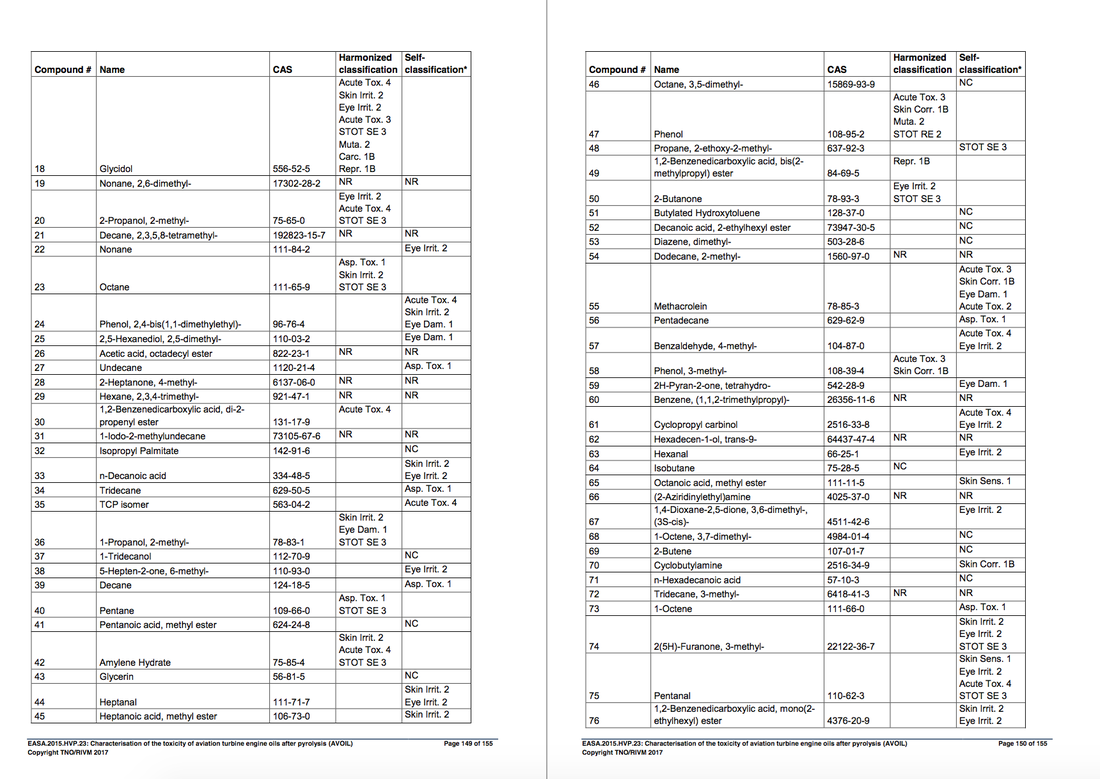|
EASA
Final Report EASA_REP_RESEA_2015_2 Research Project: Characterisation of the toxicity of aviation turbine engine oils after pyrolysis ©/all rights EASA 2015 "Appendix 6 Classification of chemicals list The following table describes the hazard profile of the list of compounds (Table 5.6) identified under both nitrogen and oxygen conditions, in all oils and during different flight stages. The hazard profile, or classification, of a substance is an indication of its intrinsic toxicity. A substance is classified, e.g. assigned a notation for a specific toxicity, according to an internationally agreed classification criteria. The classification can distinguishes between the various types of toxicity (reprotoxic, carcinogenic, irritant), the potency (4 (less potent) =>1 (most potent), the frequency needed to exert the toxicity (Single Exposure (SE) vs Repeated Exposure (RE)) and the level of evidence (1A, 1B and 2) available (for more information, see the Guidance on the criteria for Classification and Labelling under REACH). In most cases, the manufacture or importer classifies the substance without any review by an independent organisation, the so-called self-classification. Different manufacturers classify the same substance differently. Harmonized classification means the classification is agreed upon in a scientific committee and that classification is mandatory for every manufacturer or importer. The substances are run through the Classification and Labelling database of the European Chemical Agency (ECHA) database. This database contains all classification and labelling information on notified and registered substances received from manufacturers and importers in the European Union. Manufacturers and importers need to notify a substance to the Classification and Labelling (C&L) Inventory if they intent to place the substance on the EU market. " (©source) go to EASA |
127 toxic substances :
|
- HOME
- What are Fume Events?
- Unfiltered - contents of fumes
- Evidence
- CREW mask info
- The Scent of Flying Free EBook
- Chemicals With Wings
- Debate so far
- Passenger Videos
-
Filtration Expert Articles
- Ti-DOX HydroxylizAire “
- AIRBUS Filtration Problems Dec.8/1988
- Contaminated air in airliner cabins
- ASHRAE Introduction to Passenger Aircraft Cabin Air
- Aeronautical Engineering Prof. Dr.-Ing Dieter Scholz
- Horizon 2020 Breath of Fresh Air
- Patent Air Conditiong System air or rail
- Airbus Cabin Air Explanations
- Airline CEO's Obsession
- Filtration Efficiency Claims: Misleading?
- HEPA Technology Tested
- Forgotten Pollution: Cabin Air Quality
- Flying despite Corona?
- PETITION
- MEDICAL HEALTH CONCERNS at Altitude, Fumes & Vaccinations
- Disinsection
- UPDATES & NEWS
- Press Conference Airplane Safety Legislation Toxic Fumes
- AKADEMIA
- HOME
- What are Fume Events?
- Unfiltered - contents of fumes
- Evidence
- CREW mask info
- The Scent of Flying Free EBook
- Chemicals With Wings
- Debate so far
- Passenger Videos
-
Filtration Expert Articles
- Ti-DOX HydroxylizAire “
- AIRBUS Filtration Problems Dec.8/1988
- Contaminated air in airliner cabins
- ASHRAE Introduction to Passenger Aircraft Cabin Air
- Aeronautical Engineering Prof. Dr.-Ing Dieter Scholz
- Horizon 2020 Breath of Fresh Air
- Patent Air Conditiong System air or rail
- Airbus Cabin Air Explanations
- Airline CEO's Obsession
- Filtration Efficiency Claims: Misleading?
- HEPA Technology Tested
- Forgotten Pollution: Cabin Air Quality
- Flying despite Corona?
- PETITION
- MEDICAL HEALTH CONCERNS at Altitude, Fumes & Vaccinations
- Disinsection
- UPDATES & NEWS
- Press Conference Airplane Safety Legislation Toxic Fumes
- AKADEMIA
Unfortunately, we are not able to provide personalized advice to individuals on diagnosis, treatment and professional and/or legal issues. However, you will find all the information you need on these pages. We thank you for your understanding and hope that the materials on this site will help answer your questions.
Disclaimer: I am not a medical doctor but a concerned citizen collating research. The provided information should be double checked by everyone according to their personal circumstances before embarking on any treatment in consultation with their personal doctor who knows about the discussed subject and their medical history. Please make sure to present the three downloadable documents HERE for your doctor's information. This is an effort to share what I have learnt by reading many scientific and medical journals on this subject and my own experience and health journey following expsoure to fume events and onboard aerosol pesticide spraying.
Disclaimer: I am not a medical doctor but a concerned citizen collating research. The provided information should be double checked by everyone according to their personal circumstances before embarking on any treatment in consultation with their personal doctor who knows about the discussed subject and their medical history. Please make sure to present the three downloadable documents HERE for your doctor's information. This is an effort to share what I have learnt by reading many scientific and medical journals on this subject and my own experience and health journey following expsoure to fume events and onboard aerosol pesticide spraying.
All Rights Reserved © Bearnairdine Beaumont
UNFILTERED formerly known as "Aerotoxic Team" the Global Network
2013 - 2026
Latest update 26. May, 2024
music: © https://acousticevolution.bandcamp.com/track/gentle-ascent
UNFILTERED formerly known as "Aerotoxic Team" the Global Network
2013 - 2026
Latest update 26. May, 2024
music: © https://acousticevolution.bandcamp.com/track/gentle-ascent




